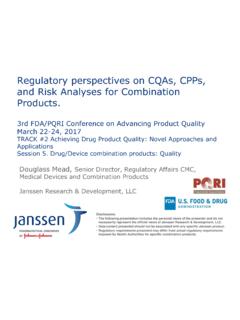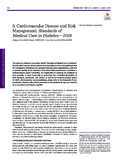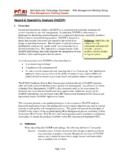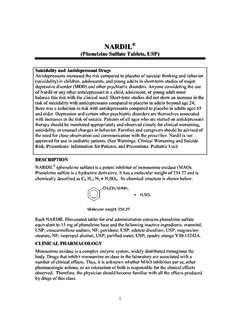Transcription of Risk Analysis of Sterile Production Plants: A New …
1 Downloaded from on June 21, 2011. Risk Analysis of Sterile Production plants : A New and Simple, Workable Approach Guenther Gapp and Peter Holzknecht PDA J Pharm Sci and Tech 2011, 65 217-226. Access the most recent version at Downloaded from on June 21, 2011. TECH REPORT. Risk Analysis of Sterile Production plants : A New and Simple, Workable Approach GUENTHER GAPP1* and PETER HOLZKNECHT2. 1. Quality Assurance Microbiology, Sandoz GmbH/Novartis, Kundl, Austria and 2 Biotechnological Production , Sandoz GmbH/Novartis, Kundl, Austria PDA, Inc. 2011. ABSTRACT: A Sterile active ingredient plant and a Sterile finished dosage filling plant both comprise very complex Production processes and systems. The sterility of the final product cannot be assured solely by sterility testing, in-process controls, environmental monitoring of cleanrooms, and media fill validations. Based on more than 15 years experience, 4 years ago the authors created a new but very simple approach to the risk Analysis of Sterile plants .
2 This approach is not a failure mode and effects Analysis and therefore differs from the PDA Technical Report 44 Quality Risk Management for Aseptic Processes of 2008. The principle involves specific questions, which have been defined in the risk Analysis questionnaire in advance, to be answered by an expert team. If the questionnaire item is dealt with appropriately, the answer is assigned a low-risk number (1) and if very weak or deficient it gets a high-risk number (5). In addition to the numbers, colors from green (not problematic) through orange to red (very problematic) are attributed to make the results more striking. Because the individual units of each Production plant have a defined and different impact on the overall sterility of the final product, different risk emphasis factors have to be taken into account (impact factor 1, 3, or 5). In a well run cleanroom, the cleanroom operators have a lower impact than other units with regard to the contamination risk.
3 The resulting number of the analyzed Production plant and the diagram of the assessment subsequently offers very important and valuable information about a) the risk for microbiological contamination (sterility/endotoxins) of the product, and b) the compliance status of the Production plant and the risk of failing lots, as well as probable observations of upcoming regulatory agency audits. Both items above are highly important for the safety of the patient. It is also an ideal tool to identify deficient or weak systems requiring improvement and upgrade, and delivers sound arguments for investments. Practical experience with this risk Analysis , which has already been executed in several Production sites in various countries, has demonstrated that it is simple, workable, and delivers valuable information. KEYWORDS: Risk Analysis , Sterility, Endotoxins LAY ABSTRACT: Many important pharmaceutical products need to be Sterile because they are to be injected into the patient's bloodstream or muscle.
4 Sterile means that the product must be free of microorganisms ( , bacteria, yeast, and moulds). A non- Sterile injection or infusion could lead to very serious or even lethal effects on the patient. Therefore one of the biggest challenges in the pharmaceutical industry nowadays is still the Sterile Production process itself. Microorganisms are everywhere in the environment, and humans are known to be a significant source of microbial contamination of a Sterile product. It is necessary to set up a very effective quality assurance system as well as many quality control Analysis tools to assure the sterility of the produced vials/syringes or of the bulk material intended for later filling into vials (bulk material, , 10 kg in bags or cans). Above all, to get an accurate indication of the risk of non-compliance of product quality, regulatory agencies such as the Food and Drug Administration and the updated Good Manufacturing Practice (GMP) Guide have made it mandatory to perform a risk Analysis of the Production process.
5 This provides in advance valuable information about the potential risk of a product's non-compliance with product specifications and GMP requirements, in our case regarding sterility. The authors set up a new approach for a risk Analysis 4 years ago; this approach stems from fundamental experience gained over the past 15 years. Several specific questions are asked regarding various topics that correlate to the Sterile Production line and associated quality assurance/control systems. If the answer for an item is satisfactory and the best system is in place with regard to sterility, it is assessed with the prime rating of 1. If the topic is not satisfactory and very weak, the response is 5. Risk numbers from 2 to 4 are for intermediate situations. Because each unit of the Vol. 65, No. 3, May June 2011 217. Downloaded from on June 21, 2011. Production process could have a different type of impact of varying severity on the total product sterility, the average of the answers regarding the unit ( , 1, 2) is multiplied by the risk emphasis factor, which could be 1, 3, or 5.
6 To make the rating even more distinct, colors are assigned from green (very good) through orange to red (very weak). There are currently three different risk analyses available for three different Production processes. The results provide the users, that is, Production personnel and quality assurance personnel, valuable feedback about the risk for possible non-sterility in their process as well as sound arguments to present to management defending upgrades of their Production line and control systems in the case of high numbers and red colors. Three years of implementation have demonstrated that this new risk Analysis approach works and is very useful in identifying potentially risky components of a Production process, thus preventing in advance the Production of non- Sterile product batches for the market, and finally protecting the patient from hazardous products.
7 1. Introduction contamination may not always be discovered. Further- more, results from microbiological quality control Over the past few years, terms such as risk-based (QC) Analysis of a sample are not as reproducible as approaches, risk management, and risk Analysis have chemical analyses ( , high-performance liquid chro- become very popular in the pharmaceutical industry. matography) because of the non-homogenous distri- One reason for this is that, for example, the Food and bution of contaminants throughout the lot. Drug Administration (FDA) started in 2003 its initia- tive Pharmaceutical cGMPs for the 21st Century: A There are numerous different root causes and possi- Risk-Based Approach to focus on critical steps in bilities for the origin of microbial contamination: a pharmaceutical Production and to use this concept for defective Production plant, a leaking primary packag- their inspections.
8 Ing container, a pressure drop in the cleanroom, poor aseptic working practices of the human operators, an A Sterile active product ingredient (API) plant is a inefficient sterilization step, and so on. To make the very complex Production system with regard to the situation even worse, these manifold possibilities for technology, associated cleanroom operations, and the the origin of the contaminants are linked with the many controls and processes involved. A Sterile fin- limited detection rate of microbial Analysis as men- ished dosage form (FDF) product filling line with tioned above. liquid or solid product filling seems to be more easily controlled than an API plant, as fewer Production steps Regulatory agencies and company management re- are required. quire the quality assurance (QA) microbiologist to perform a successful investigation with a clear and The sterility of an aseptically processed product can- rapid identification of the problem, to define CAPAs not be 100% assured; however, it is essential to keep (corrective and preventative actions), and, subse- the risk for the patient as low as possible.
9 It is common quently, to make or propose the correct batch dispo- knowledge that traditional sterility testing is of very sition decision both for the sake of the patient and, limited help in detecting microbial contamination, and ideally, for the lowest loss by the company as well. As even combined with increased sampling for environ- a result he or she has to write a scientifically sound mental monitoring and with numerous media fill val- investigation report that has to fully satisfy all audi- idations some uncertainty remains. tors. Therefore, the position of a QA microbiologist is often very challenging. It is therefore no surprise that Microbiology in the pharmaceutical industry is a very in worldwide conferences many presentations with challenging field because the root cause of microbial topics like Training in Handling of Microbiological Deviations are offered to give advice and assistance in reaching the right conclusion.
10 * Corresponding author: Guenther Gapp, Sandoz GmbH, Biochemiestrasse 10, A-6250 Kundl, Austria. Imagine this scenario: you are a microbiogical labo- Phone: 43 5338 2002562. Fax: 43 5338 2003441. ratory supervisor sitting in your office, the door opens, Email: and your lab technician informs you that non-steril- ity has been detected in your company's most impor- doi: tant Sterile product that is expected to be launched in 218 PDA Journal of Pharmaceutical Science and Technology Downloaded from on June 21, 2011. Aseptic Filling Justification: 1- 5 Unit Risk Emphasis Factor: 3. Unit Average Risk Factor Unit Risk Factor Questions Possible Justification Q301 Aseptic filling room/ Closed isolator (1), mousehole (2), barrier (3), or open manipulations in class A (5) 1. clean room concept 1/2/3/5. Q302 1/5 If closed isolator: located within classified background (1) or non classified background (5) 1.





